Currency
The following 3 reasons suggest that the Canadian dollar might be undervalued against the USD:
The Canadian dollar heavily depends on the price of oil. Regression analysis as well as other interest theory suggests that the Canadian dollar is currently 8% undervalued.
The following chart shows the strong relationship between the Canadian dollar and the price of oil over the last 30 years (from January 1986 through April 2016). The monthly exchange rate data is from the Bank of Canada. The monthly price of oil is from Department of Energy.
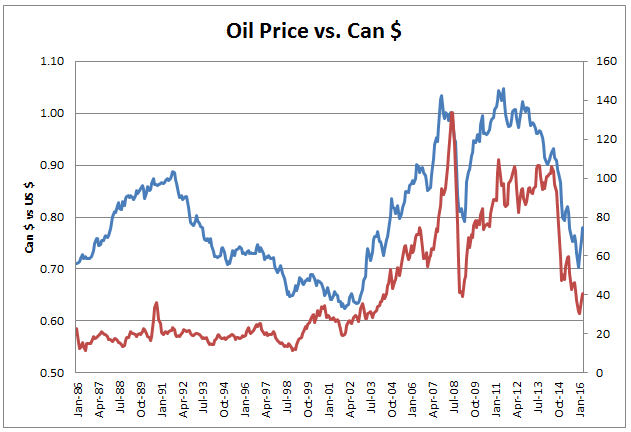
related, Victor Adair with Michael Campbell: A Significant Turn In The US Dollar
US Dollar , Back From the Grave ?
There are several times a year when the markets gives you an important inflection point. Today I believe we just witnessed one in regards to the PM complex, the US dollar and the stock markets. Even though the US dollar didn’t have an extremely big up day it did show its hand by breaking out of a downtrend channel while the PM complex had a tougher day breaking down from a small topping pattern we looked at earlier today. Also the stock markets had a very good day to the upside with some completing small double bottoms or falling wedges.
 Soros triggered Black Wednesday in 1992 by selling short a massive amount of British pounds. Dubbed “the man who broke the Bank of England” with that very profitable trade, now Soros is heavily long on gold and short the US stock market.
Soros triggered Black Wednesday in 1992 by selling short a massive amount of British pounds. Dubbed “the man who broke the Bank of England” with that very profitable trade, now Soros is heavily long on gold and short the US stock market.
George Soros Was Once a Dollar Vigilante, Now a Ring Wraith Buying Gold
One of the inspirations for our name, The Dollar Vigilante, was what used to be called the Bond Vigilantes.
Last seen in full force in the inflationary early 1980s, bond vigilantes were anti-establishment figures who were said to have rebelled. They had decided to keep central banks and governments honest by raising long term interest rates in the open market. They would do so whenever the authorities kept their own interest rates too low, or let budget deficits grow out of control.
It was in 2010 that I overheard the term “bond vigilante” on a radio program once again and laughed for a moment, saying in my own head, Ah, yes, with interest rates at near zero or negative percent, Quantitative Easing to infinity and budget deficits in the US stretching the boundaries of belief, where are the bond vigilantes now?
And I thought to myself, I guess the system is so far out of control now that you can’t sell bonds to keep central banks or government under control as they’ll just print up unlimited money to keep buying it.
I then had an epiphany and told myself, “What we need today are dollar vigilantes!”
That’s what started this all…
In a sense, George Soros is a fellow dollar vigilante. An outsider who once tried to break the system… and he did.
On September 16, 1992, Black Wednesday, he sold short more than US$10 billion worth of pounds (which is just play money today but back then it was a massive amount) against the Bank of England. He was betting on its reluctance to raise its interest rates or float its currency.
The BoE finally withdrew the currency from the European Exchange Rate Mechanism, devaluing the pound sterling, and earning Soros an estimated US$1.1 billion. He was dubbed “the man who broke the Bank of England”.
And for that, we cheer(ed) him! What happened, in my estimation is that the ring of power (that’s what the Lord of the Rings, by anarchist J.R.R. Tolkien was all about) is so strong that no one can be uncorrupted by it.
Anyway, George was called to Buckingham palace to see the Ring Master herself, the Queen of England. That must have been quite a conversation. Afterwards, George became a ring wraith. He started his foundation and became the leftist power he is today.
He became part of the New World in other words.
These days he clearly functions at the highest (public) levels, overthrowing countries to support the coming global order. And he raises funds to support organizations like Black Lives Matter to keep the people divided and chaotic. The more social turmoil there is, the easier it is to manipulate people and even whole societies. That’s how globalism is achieved.
SO WE MEET AGAIN
Now we meet George again. Not as a dollar vigilante but as a wring wraith and fellow gold buyer. He’s heavily long on gold and short the US stock market.
He’s plunging into gold buying 19 million shares from Barack Gold valued at over $260 million. He’s purchased 1.05 million shares of the SPDR Gold Trust ETF and doubled his short-sell on the U.S. S&P 500 Index.
You can see the dramatic sell-off of long equity holdings here:

Notice that the most recent sell-off began in September 2015, at the end of the Shemitah Year and beginning of the current Jubilee Year.
Buying and selling the same things as George Soros is a somewhat queasy idea for us here at TDV.
But, while we both expect to profit massively, his intention is to use his profits to further push the new world order agenda. Ours is to help others survive and profit and be ahead of the game… and create additional freedom wherever we can.
Perhaps our ever-growing worldwide network of dollar vigilantes can help topple the system before it reaches its ultimate end. If so, we have stated our intention is to throw the ring of power (governments and central banks) into Mount Doom if we have the chance. Frodo showed, however, no matter how well intentioned, the ring is too powerful for any mortal.
We’ll have to deal with that if we get there. In the meantime, we’ll be positioning ourselves and subscribers just like George (Sauron) Soros.
In The Lord of the Rings, remember that the ring was a metaphor for government/central banks and top down control of all of Middle Earth written by an anarchist. If you never realized it, its a whole different movie.
In the real world, we’re the men, elves, dwarfs and the hobbits trying to survive. We’re hunkered down in the Shire preparing for a great battle as the NSA all seeing eye tries to watch everything we do, the ring wraiths (the intelligence agencies) and the army of orcs (the military industrial complex) ready themselves to try and take over.
Both sides are preparing by accumulating precious metals, gold stocks, bitcoin, hard assets and shorting the system that soon will cease to exist after the upcoming Great War. Whose side are you on?
related: Fellow billionaire Stanley Druckenmiller calls Gold his “largest currency allocation”.
Victor on the importance a May 3rd turnaround in the US Dollar, the most influential and strategic currency traded, and the near term direction of Gold & the CDN Dollar. He also describes a positioning risk tool that he uses a lot in determining where other markets are going.
also:
Mike with Ozzie Jurock and 2 Hot Properties as well as new regulations in real estate that are coming
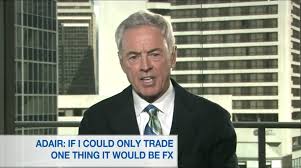 About Victor Adair:
About Victor Adair:
Victor Adair has been trading commodities for 35 years and has held several senior jobs in the brokerage community. He is now senior vice president and derivatives portfolio manager for MF Global Canada Co., a unit of MF Global Ltd., the leading broker of exchange-listed futures and options in the world. He currently trades on behalf of a group of high net worth individuals and corporations. He’s also a market analyst and frequent speaker at investment conferences throughout North America.
Quotable
What is our life? A play of passion,
Our mirth the music of division,
Our mother’s wombs the tiring-houses be,
Where we are dressed for this short comedy.
Heaven the judicious sharp spectator is,
That sits and marks still who doth act amiss.
Our graves that hide us from the setting sun
Are like drawn curtains when the play is done.
Thus march we, playing, to our latest rest,
Only we die in earnest, that’s no jest.
–Sir Walter Raleigh, Life
Commentary & Analysis
Chart View: A look at some charts we follow which may be of interest…
Page 2: Commodities/Stock Ratio
Page 3: Inflation in stocks versus commodities
Page 4: Japanese stocks versus the yen
Page 5: Copper as a bell whether?
Page 6: Silver looking good
Page 7: GBP/USD Weekly
Page 8: UK gaping current account deficit
Stocks/Commodities Ratio: We shared this chart many moons ago in Currency Currents. Just checking in; nothing profound to add here other than to suggest how interesting the symmetry of this pattern. From left to right viewing the chart below, we saw a 10-year bear market move in the ratio (i.e. commodities outperformed stocks); and now we are in 8-years bull market move in the ratio, i.e. stocks have outperformed commodities). Obviously we don’t need to see a big bull move in commodities for this ratio to work lower; we only need to see stocks underperform.
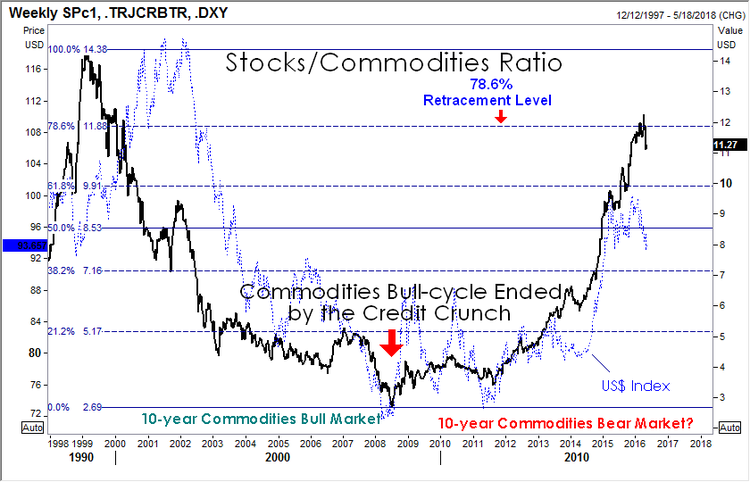
Inflation? You bet. Not in real goods (yet) but definitely in stock prices (financial assets—money has to go somewhere). This is why the 1% are happy with the status quo. This is why those with professional jobs with access to capital are happy and asking: What recession? So all you brainiac’s who read The New York Times, The Wall Street Journal, or The Washington Post and actually believe the pap printed, and can’t quite figure out why all those stupid hicks in the hinterlands (I am happy to be among them) are voting the way they do—take a look. Real economy in the toilet. The financial economy for those educated in the right places, and those who believe they are but are simply lucky, is doing very well.
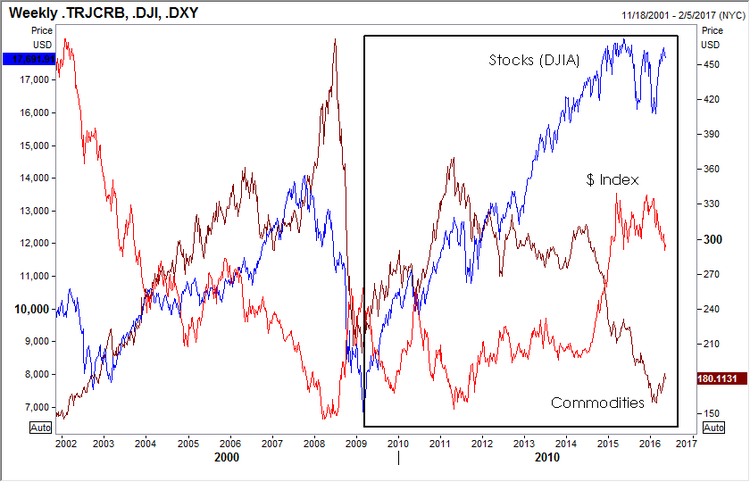
Japanese Stocks versus the Japanese yen: Gosh the yen looks expensive and overdone. The Bank of Japan policy backfired relative to the needs of Japan when NIRP (Negative Interest Rate Policy) was announced. We want to load up long on $/yen, but this chart gives us pause. It shows Japanese stocks, measured by the Nikkei 225 Index (black line), and USD/JPY currency pair (red line). Visually, a pretty tight correlation—weak stocks and strong yen. It is interesting because the Japanese government already owns a huge amount of major listed stocks—what will it take to drive the Nikkei 225 higher? We aren’t sure, but when we see it I think we should get long USD/JPY. Note: A fresh swing low in USD/JPY, but not yet for the Nikkei. Maybe a non-confirmation setting up? Stay tuned.
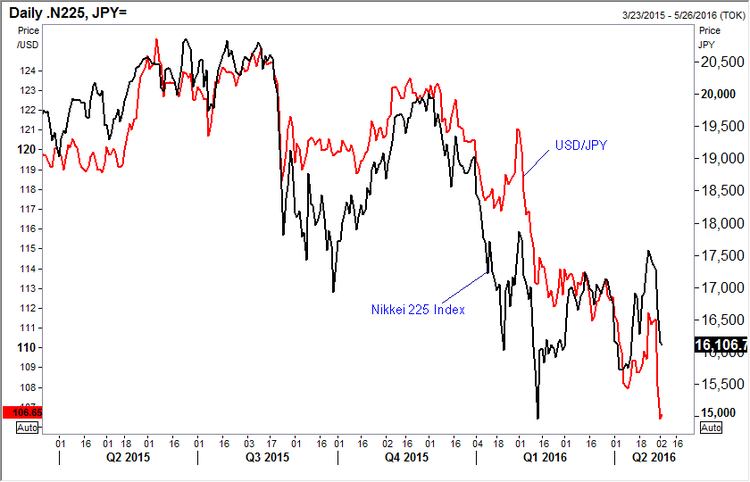
Copper, the big question. Real demand or Chinese speculation accounting for the recent “rally”? If global growth is indeed on the wane yet again, and the IMF is so warning, as data across the board isn’t encouraging, we would expect copper to tumble again. Maybe it isn’t over till we see a round trip in the metal (labeled at Alt 2). This may very well be the bell whether for the rest of the commodities pack. Worth watching even if you don’t care to play. Note the retracement down to yet another key level—78.6% (1.9665)–before turning higher. Obviously hindsight makes all of us geniuses, but it is interesting how often these key levels are respected.
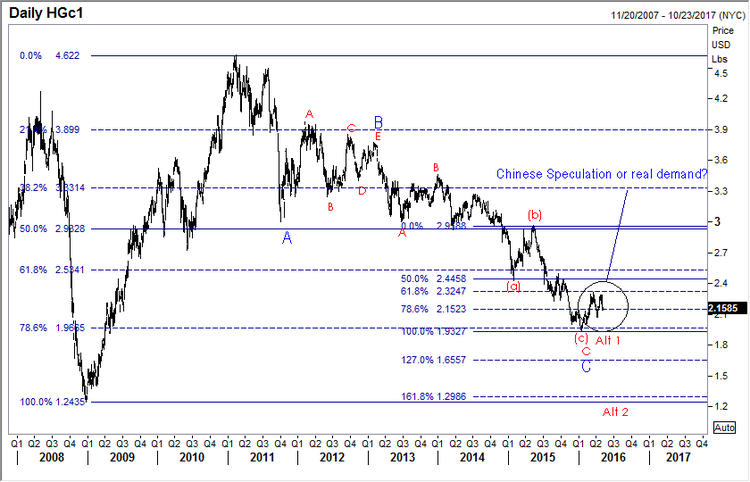
Silver looking good. We got a trend break higher in silver back on February 2nd, 2016 and we got some confirmation on a move above 15.90 [a la Victor Sperandeo trend line technique]. Now looking for at least 21.53 if this move is for real. Resistance becomes support, so a close back below 15.90 concerns.
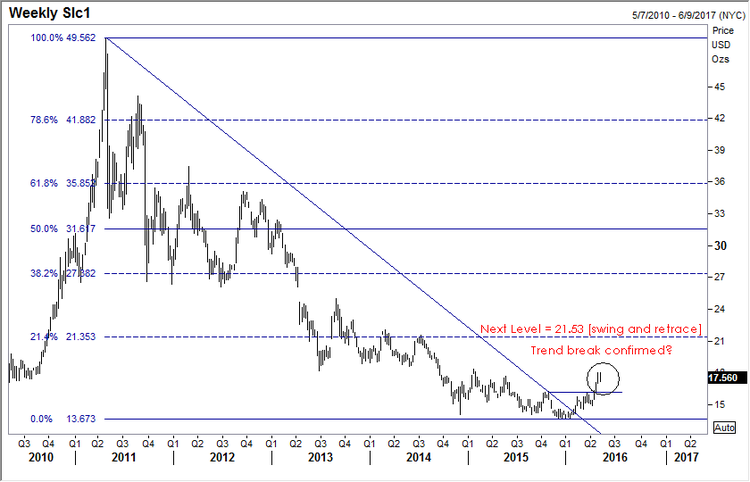
GBP/USD Weekly: We shared this chart with our subscribers yesterday, in support of our short position in the pound. I won’t belabor the Brexit issue, you all know the status and the propaganda so associated. I do wish to add: Why the Brits would ever listen to anything President Obama says regarding Brexit is beyond my comprehension—Mr. Meddler he was on his latest trip to Europe. You’ve got enough of your own problems here at home Mr. President, in case you haven’t noticed. And now that you are playing the role of Hillary Clinton’s full-time mouthpiece and hit man, just open up a can of STHU when it comes to Brexit and let the Brits decide for themselves what they care to do. And on that score, it seems, based on the latest data, the UK economy is slowing. Whether Brexit related or not, no matter. The pound seems to be losing yield coverage as growth fades; and as you can see in the chart below, there seems a pretty good correlation with the direction of the UK 10-year benchmark yield (green dotted line) and GBP/USD. The chart on the next page is the UK current account. It shows massive red ink. Not sure it this matters. But if it does start to matter, it likely won’t be good for British pound sentiment.
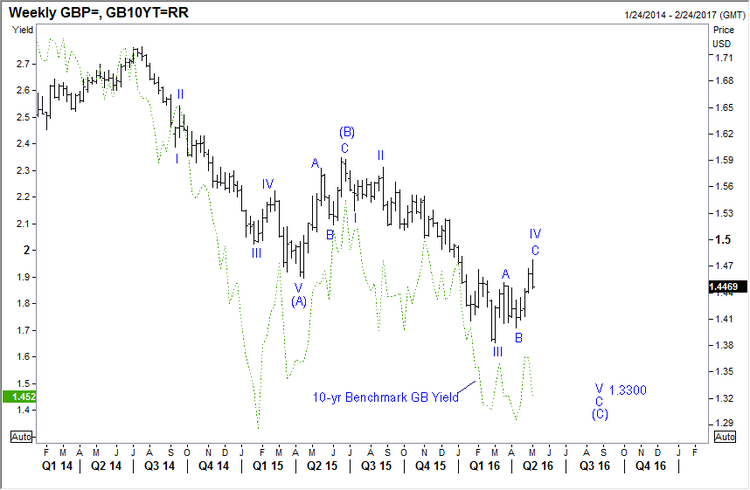
UK Currency Account Quarterly: Ugly to uglier!

Happy Friday. Now the really tough question: Gin and tonic (Beefeater 24), or single malt (Glenmorangie 10 year)?
Jack Crooks
President, Black Swan Capital
related: What Gold Does In A Currency Crisis, Canadian Edition














